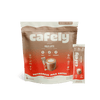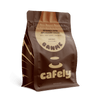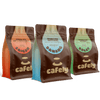Spanish coffee is an indulgent coffee cocktail that contains dark rum, coffee liqueur, and Grand Marnier. It’s garnished with a dollop of whipped cream and is perfect as an after-dinner treat during the colder months.
If you enjoy Irish coffee, you’ll love Spanish coffee. In this article, you’ll learn how to make a traditional Spanish coffee as well as five similar brews to try from across the globe.
What You’ll Need to Make Spanish Coffee

Spanish coffee is a complex coffee-based alcoholic beverage that requires a few ingredients and some specific pieces of equipment.
You may not have all the ingredients and brewing equipment you need in your kitchen to make Spanish coffee. However, once you buy the liquor and a good coffee machine, you’ll be able to make this indulgent brew whenever you want.
Here’s what you need to make Spanish coffee
Ingredients
- Arabica coffee
- Water
- White sugar (1 ½ teaspoons)
- Aged dark rum
- Grand Marnier
- Kahlua
- Heavy Cream
- Orange wedge
Equipment
- Coffee grinder
- French press or drip coffee maker
- Large mixing bowl
- Whisk
- Shot glass
- Tablespoon
- Kitchen blow torch
- Heatproof serving glass
Coffee Recommendations
Traditionally, Spanish coffee is made from 100% arabica coffee. The best coffee to use should be roasted dark and ground fresh. It’s best to grind whole beans yourself to produce a coffee with a complex flavor profile and a deep richness.
We recommend Cafely DaLat coffee. This coffee comes in whole beans or pre-ground varieties. It has notes of caramel, blackberry, and stonefruit — the perfect pairing for the dark rum and Grand Marnier in Spanish coffee.
Our DaLat coffee contains 100% Vietnamese-grown arabica coffee sourced from sustainable farms. It’s dark-roasted and can be brewed with a range of equipment — a phin filter, espresso maker, moka pot, drip coffee maker, AeroPress blends, and pour-over brewers.
How to Make Spanish Coffee: Step-by-Step Guide
Spanish coffee is relatively easy to make, but it requires accurate measuring and a bit of patience. Mastering the balance between coffee, alcohol, and cream can be a challenge at first, but you'll quickly learn how to make the perfect balanced brew with this recipe.
Here’s how to make Spanish coffee at home:
1. Grind the Coffee
First, grind the 100% arabica coffee to a coarse texture. Aim for a grind similar to the consistency of flakey sea salt. You’ll need around 17 grams (two to three tablespoons) of ground coffee per serving.
2. Brew the Coffee
Brew a strong, dark coffee using a French press, drip coffee maker, or pour-over brewer. Add sugar to sweeten (optional).
3. Prepare the Glass
Take an orange wedge and coat the rim of your heatproof glass. Pour white sugar on a plate, and press the rim of the glass in the sugar to coat evenly.
Using a blow torch, carefully caramelize the sugar around the rim.
4. Whip the Cream
In a large mixing bowl add a quart of a cup of heavy whipping cream. Whip the cream using a whisk until stiff peaks form. The cream should be thick but pourable.
5. Mix the Liqueurs
In the glass, mix aged dark rum, Grand Marnier, and Kahlua in equal parts. Use half a shot of each for an average-strength Spanish coffee or a shot of each for a strong Spanish coffee.
6. Add the Coffee
Pour in the black coffee, making sure to leave room at the top of the glass for the cream. Stir to combine the alcohol and coffee.
7. Garnish and Serve
Add a dollop of whipped cream to the brew, ensuring that it sits on top of the coffee, creating a layered effect. Garnish with orange zest and a couple of roasted arabica coffee beans.
Serve and enjoy while hot. The dark brew should be slowly sipped through the cream — do not mix the two; let them filter naturally.
Five Brews To Try After Spanish Coffee
If you enjoyed the Spanish coffee and want to experience other brews from across the globe, try these five:
1. Mexican Coffee (Café de Olla)

Mexican coffee (Café de Olla in Spanish) is a complex brew birthed in Mexico — hence the English name. The word “Olla” comes from the pot it’s brewed in — a clay pot that’s traditionally heated over a fire or hot sand.
Café de Olla is a spiced coffee that contains arabica coffee, cinnamon, and Piloncillo (unrefined cane sugar). It’s dark, sweet, and indulgent.
Here’s what you’ll need to make Mexican coffee:
- 100% arabica coffee
- Cinnamon
- Piloncillo (unrefined cane sugar)
- Water
You’ll also need:
- An Olla (traditional clay brewing pot)
- A gas stove or open fire
- Coffee grinder (if using whole bean coffee)
- A fine sieve or cheesecloth
- Your favorite coffee mug
Here’s how to make Café de Olla the traditional way:
- Grind the coffee — Coarsely grind arabica coffee beans. You’re looking for a texture similar to sea salt and will need around four tablespoons of ground coffee for an average-sized Olla (two to four servings).
- Heat the water — Fill the Olla with three to four cups of water and bring it to a simmer on a gas stove or open fire.
- Add the ingredients — Lower the heat of the stove or move the Olla to a cooler part of the fire. Then, add four tablespoons of coffee, three ounces of piloncillo, and a stick of Mexican cinnamon to the water. Stir to combine.
- Brew the coffee — Remove the Olla from the heat, cover, and let it steep for five minutes.
- Strain and serve — Strain the coffee by pouring it through a fine sieve or cheesecloth into the coffee cups. Serve and enjoy.
2. Cuban Coffee (Café Cubano)

Cuban coffee is an espresso-like brew prepared using a stovetop moka pot. There are four main types of Cuban coffee. They’re all similar but differ slightly in preparation and ingredients.
The four main types of Café Cubano are:
- Cafecito
- Colada
- Cortadito
- Café con leche
The cafecito is the simplest form of Cuban coffee. It’s a small, concentrated espresso-like brew that’s made from finely ground arabica coffee or a blend of robusta and arabica.
It’s served in small espresso-sized cups and is topped with espuma — a sugar foam that’s made by whipping the first drip of coffee with a teaspoon of white sugar.
The colada is similar to a cafecito but is served in a styrofoam cup with six thimble-sized drinking cups. It’s made to be shared among a group of friends.
The cortadito is made in the same way as the cafecito but is served with steamed milk at a 1:1 ratio.
Café con leche is similar to a latte. It contains one part cafecito and two parts steamed milk. However, the two components are often served separately so the consumer can decide how much milk they add to the coffee.
Making Cuban coffee at home is a flavorful and cultural experience worth trying.
3. Turkish Coffee

Turkish coffee is an unfiltered coffee made from finely ground arabica coffee. It's brewed in cezve and is served in small espresso-sized cups. This unique brew is boiled rather than brewed, which creates a dark, rich brew with a rich, thick crema.
Here’s what you’ll need to make Turkish coffee:
- Extra fine-ground arabica coffee
- Cold water
- Sugar (optional)
- Cezve (traditional brewing pot
- Gas stove
- Small, espresso-sized cups (fincans)
Here’s how to make Turkish coffee step-by-step:
- Fill the cezve with coffee — Add finely ground arabica coffee to the cezve. The coffee should be ground as finely as possible — almost the texture of talcum powder. Add one heaped teaspoon per serving.
- Add the water — Add 80 to 100 mL of cold, filtered water (per serving) to the cezve. Gently stir the water and coffee until combined. Add sugar (if using) at this stage.
- Bring to a boil — Over medium-low heat, bring the brew to a boil. Just before the brew begins a rolling boil, remove from the heat.
- Scoop off the foam — Remove the foam from the cezve using a spoon. Don't discard it; save it in a cup for later.
- Repeat the process — Return the cezve to the heat, bring to a boil, remove, and harvest the foam. Repeat this process two to three times.
- Rest the coffee — Once brewed, rest the cezve on the counter. This will allow the fine grounds time to settle to the bottom of the pot.
- Serve the coffee — Gently pour the coffee into the fincans (or small espresso-sized cups. Add a spoonful of foam to each cup and serve. Turkish coffee should be sipped slowly and savored. Avoid drinking the last sip in the cup; this will contain fine coffee grounds.
4. Irish Coffee

Irish coffee is a dark, rich coffee that’s combined with Irish whiskey, brown sugar, and a dollop of whipped cream. This alcoholic coffee is a favorite among coffee and whiskey lovers in the wintertime. There's little better than enjoying an Irish coffee by the fire while the snow is falling outside.
Here's what you need to make Irish coffee:
- High-quality coffee
- Water
- Irish Whiskey (Jameson or similar)
- Demerara sugar
- Heavy cream
Here’s how to make Irish coffee at home:
- Brew the coffee — Brew a strong cup of coffee using a drip coffee maker, French press, or pour-over coffee brewer.
- Whip the cream — In a large mixing bowl, add a small amount of heavy cream. Whip the cream until stiff peaks form. The cream should be thick and airy but pourable.
- Add the sugar — In a heatproof glass (ideally one made for Irish coffee), add a teaspoon of demerara sugar.
- Add the whiskey — Pour in one to one and a half shots of Irish whiskey to the glass. Jamerson is the most popular whiskey for Irish coffee.
- Pour the coffee — Gently pour the coffee into the glass, leaving room for the cream at the top.
- Add the cream — Add a dollop of whipped cream to the coffee. Don't mix the coffee and cream; you should see distinct layers in the whiskey, coffee, and cream.
- Garnish and serve — Add a dash of brown sugar to the cream and a couple of whole coffee beans to the cream (optional). Serve and enjoy while hot.
5. Espresso Martini

An espresso martini is a chilled coffee cocktail that contains espresso, vodka, and coffee liqueur. It’s an elegant cocktail that’s definitely the “in” drink at the moment.
Here’s what you need to make an espresso martini:
- One shot of espresso
- Two ounces of vodka
- One ounce of Kahlua (or similar coffee liqueur)
- Ice
Here’s how to make an espresso martini:
- Brew the espresso — Brew a single shot of espresso and leave it on the counter to cool.
- Prepare the glass — Add crushed ice to a martini glass to cool.
- Assemble the drink — In a cocktail shaker, add crushed ice, the cooled espresso, two ounces of vodka, and one ounce of Kahlua. Shake vigorously until chilled and mixed.
- Pour the martini — Remove the crushed ice from the martini glass. Pour the contents of the cocktail shaker through a fine metal strainer into the glass.
- Garnish and serve — Garnish the martini with a few whole roasted arabica beans, serve, and enjoy.
FAQs: Spanish Coffee

Want to learn more about Spanish coffee and other unique brews?
Check out the Cafely Blog and have a read through the answers to the frequently asked questions below…
1. What is Mexican Coffee?
Mexican coffee (Café de Olla) is a sweet, spiced brew made from arabica coffee, cinnamon, and piloncillo (unrefined cane sugar). It's traditionally brewed in an "Olla" (clay pot), which gives the coffee its unique, somewhat earthy flavor.
2. What Type of Coffee is Used for Spanish Coffee?
Spanish coffee is typically made with strong, dark roast coffee. Arabica coffee is popular, but blends containing robusta beans are often used for their slight bitterness. The strong flavors of dark roast coffee pair beautifully with the alcohol and cream.
3. What is Turkish Coffee?
Turkish coffee is a rich, dark, full-bodied brew served in small espresso-sized cups called fincans. Extra fine arabica coffee grounds are boiled several times in a cezve (also known as a traditional ibrik pot). This process creates a strong, concentrated brew with a prized, foamy crema on top.
4. What is Cafè Cubano Coffee?
Cafè Cubano — often known as Cuban coffee — is a strong, sweetened espresso that's a staple of Cuban coffee culture. It's typically brewed using an espresso machine or stovetop moka pot. The brew is garnished with “espuma” (a foam made by whipping a small amount of espresso with sugar) — this is what sets the Cafè Cubano apart from other espresso-based drinks.
5. What is Cold Brew Coffee?
Cold brew coffee is made by brewing coarse-ground coffee in cold water. The brew is left for 18 to 24 hours in a fridge before straining and serving black. It's a mild brew with a low acidity compared to hot-brewed coffee and iced coffee.
6. How Do You Make Iced Coffee?
Iced coffee is made by brewing a hot, concentrated shot of coffee that's then cooled, poured over ice, and combined with milk and sugar. There isn't one type of coffee used, and the brewing method isn't important when it comes to iced coffee.
7. What’s the Difference Between Pour-Over and Drip Coffee?
Pour-over and drip coffee are extremely similar. Both brews are made by pouring hot water over ground coffee through a paper filter. However, drip coffee is made using an automatic machine, and pour-over is made by manually pouring water over the coffee.
8. How Should You Store Coffee Beans?
Coffee beans should be stored in airtight containers in a cool, dark place. When properly stored, whole, roasted coffee beans will last for two to three months.
9. What’s the Traditional Way to Serve Spanish Coffee?
The traditional way to serve Spanish coffee involves mixing espresso with brandy, rum, or Licor 43 (Spanish liqueur). The alcohol is poured first before igniting (flaming) and extinguishing with a shot of coffee. It's traditionally served with a dollop of whipped cream with a dash of cinnamon on top — just be mindful of the recommended amount of cinnamon in coffee to avoid overpowering the drink’s balance.
10. What Country Drinks the Most Coffee?
Per capita, Finland drinks the most coffee. The average Finnish person consumes around 12 kilograms (26.5 pounds) of coffee per year. The United States is the biggest importer of coffee, but the average American drinks just four kilograms (9 pounds) of coffee per year.










